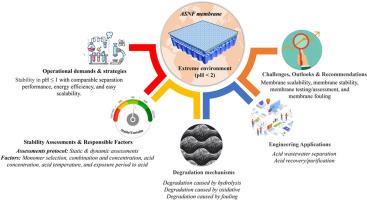Acid-stable nanofiltration membranes: Emerging materials for sustainable separation in harsh and extreme conditions
IF 9.5
引用次数: 0
Abstract
Acid-stable nanofiltration (ASNF) membranes have emerged as a transformative technology for enabling efficient and selective separations in chemically aggressive environments encountered across various industrial sectors. Applications such as acid mine drainage treatment, copper smelting and refining, steel pickling, hydrometallurgy, biomass processing, and resource recovery require membrane systems that can withstand extreme pH levels and elevated temperatures. This review provides critical insights into the current state of ASNF membranes, particularly those developed at the bench scale, and highlights the operational limitations of conventional membranes under such harsh conditions. It examines recent progress in ASNF membrane fabrication/material design strategies, and performance metrics in extreme environments alongside the chemical mechanisms that underpin their durability. Additionally, their applications in acidic wastewater separation and recovery are examined. Challenges encountered in their development and application, with prevailing research gaps including limited long-term stability data, scalability constraints, and the absence of standardized evaluation protocols are highlighted. Finally, perspectives for future studies in academia as well as industry are recommended, including molecular-level material engineering, selective nanomaterial integration, and data-driven design approaches. By bridging fundamental membrane science with industrial relevance, this review underscores the vital role of ASNF membranes in advancing sustainable separation technologies to achieve both industrial and ecological benefits.

耐酸纳滤膜:在恶劣和极端条件下可持续分离的新兴材料
耐酸纳滤(ASNF)膜已成为一种变革性技术,可在各种工业部门遇到的化学腐蚀性环境中实现高效和选择性分离。酸性矿山排水处理、铜冶炼和精炼、钢铁酸洗、湿法冶金、生物质处理和资源回收等应用需要能够承受极端pH值和高温的膜系统。这篇综述对ASNF膜的现状,特别是那些在实验规模上开发的ASNF膜提供了重要的见解,并强调了传统膜在如此恶劣条件下的操作局限性。它研究了ASNF膜制造/材料设计策略的最新进展,以及极端环境下的性能指标,以及支撑其耐久性的化学机制。并对其在酸性废水分离与回收中的应用进行了探讨。在其开发和应用中遇到的挑战,主要是研究差距,包括有限的长期稳定性数据,可扩展性限制以及缺乏标准化的评估协议。最后,展望了未来学术界和工业界的研究前景,包括分子水平的材料工程、选择性纳米材料集成和数据驱动的设计方法。通过将基础膜科学与工业相关联系起来,本文强调了ASNF膜在推进可持续分离技术以实现工业和生态效益方面的重要作用。
本文章由计算机程序翻译,如有差异,请以英文原文为准。
求助全文
约1分钟内获得全文
求助全文

 求助内容:
求助内容: 应助结果提醒方式:
应助结果提醒方式:


